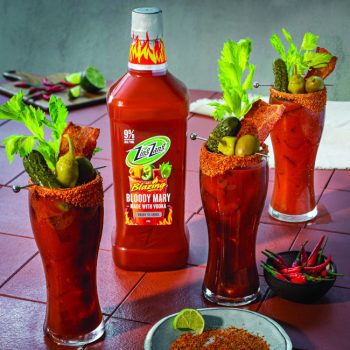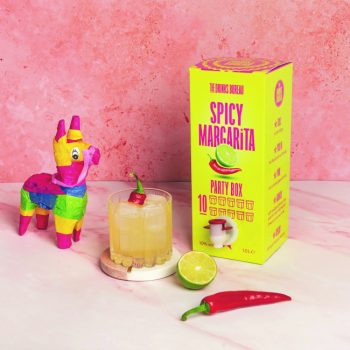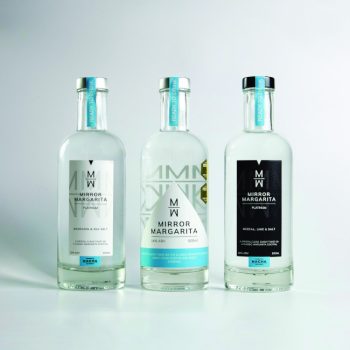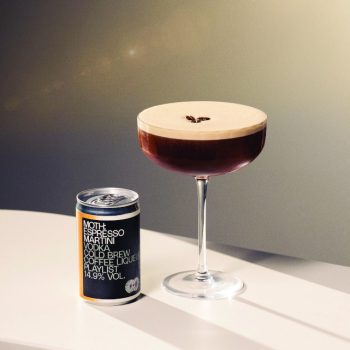Can festival: the rise of RTDs
As the ready-to-drink category matures and growth rates stabilise, we investigate how the sector is likely to develop over the coming years.

*This feature was originally published in the January 2024 issue of The Spirits Business magazine.
Generalisations about the ready-to-drink (RTD) sector as a whole, cohesive thing are seldom particularly useful. Not only is this a broad and diverse category, but an innovative and rapidly changing one too. When one subdivision reaches its inevitable peak and begins its decline, there are others poised to take its place.
“Opportunities need to be looked at on a subcategory level within RTDs,” says Susie Goldspink, head of RTD insights for IWSR Drinks Market Analysis, who points out that while hard seltzers have either hit a plateau or are in decline in a number of markets, there are strong performances from other RTDs, such as higher-strength cocktails and FABs (flavoured alcoholic beverages).
This is reflected in recent IWSR forecasts, which halved expected growth of RTDs across 10 key markets around the world, to a volume compound annual growth rate (CAGR) of 2% between 2022 and 2027. Without hard seltzers, however, this figure is 5%. This is being driven by existing spirits brands producing RTD formats, hard seltzer brands evolving beyond their category, startup brands making RTD cocktails, and more. The move is towards more flavour, and often higher-ABVs – when brands aren’t joining in on the growing zero-ABV RTD trend.
Fredrik Syren, global managing director for Pernod Ricard’s RTD and convenience business unit, describes the dynamics in RTD subsegments as nuanced, adding that the fastest-growing are the ones in which the company operates. “Our portfolio includes many premium brands that are perfectly fit to be consumed as cocktails and long drinks,” he says.
As IWSR’s Goldspink says: “We are seeing cocktails and long drinks from well-known spirits brands trying to capture the higher-strength cocktail market and leverage the brand equity and loyalty of spirits brands.”

For other cocktail RTD brands, it’s about real spirits, and the quality of the ingredients on the whole. “The surge of the past three years is coming back down to earth for malt-based drinks, but spirits-based RTDs are still growing and still generating considerable consumer excitement – it’s really one of the only growth drivers in the spirits world,” says Brent Albertson, CEO of US mixer and RTD brand Zing Zang.
A focus on real spirits is proving beneficial for hard seltzer brands such as High Water too. Founder Nick Britton reports growth for the brand in the premium end of the subcategory in the UK, as the market consolidates. “The main challenge we had before 2023 was a lack of awareness of the hard seltzer category, but that’s changing,” he says.
Meanwhile, US brand Funny Water is offering an alternative to conventional hard seltzers, by not only omitting carbonation, but offering a healthier alternative with a lower ABV of 3.75%, and therefore lower calories. “While the seltzer category has peaked, and has been declining significantly in the past couple years, the low- and no-alcohol category is showing strong compounded growth, and is expected to continue as consumers look for healthier alternatives,” says CEO and co-founder PJ Loughran.
For Dean Ginsberg, co-founder of canned vodka and soda brand Served, growth in the category will come from bar-quality cocktail RTDs. “We source only the finest natural and sustainably sourced ingredients, and our cocktails are crafted with a double measure of premium spirit, replicating the flavour and quality you would find in your favourite bar,” he says. “We are seeing significant demand from consumers for a convenient solution to consume bar-quality cocktails at home or on the go, and they’re willing to pay a more premium price.”
Bar-quality serves
Convenience, after all, is the one thing RTDs have in common. Speaking of the BrewDog’s Wonderland Cocktails range, made with the company’s own spirits, head of product marketing Dan Jones says “it’s all about delivering bar-quality serves to consumers without any of the hassle that goes with it”.
Rob Wallis, co-founder of UK cocktail brand Moth, agrees. “The convenience factor continues to be a major driver, with consumers appreciating the ease of enjoying premium cocktails without the need for numerous ingredients and faff.”

Frankie Snobel, chief of drinks for RTD cocktail brand The Drinks Bureau, notes the long-term opportunity for RTDs: “Consumers want delicious cocktails at home, or in venues that may not have bar staff. There is a huge opportunity here for RTDs to fill this demand, thrive and stick around for the long term.”
For the UK’s Whitebox Cocktails, with its distinctive, diminutive cans containing premium, full-strength serves, convenience is a factor, but the primary focus is on the drinks themselves – unsurprising given the team of bartenders behind the brand.
“We don’t see ourselves as an RTD brand in a traditional sense,” says co-founder Josh Rennie. “Our belief is that people will continue to want classic cocktails made to the proper recipes, regardless of what is happening in the RTD market.”
Conversely, what’s happening in the broader drinks world invariably has an effect on the RTD category, such as the continued rise of agave spirits. Pernod Ricard’s Syren says: “The popularity of Tequila, particularly as an RTD base in select markets, led us to introduce a ready-to-serve Altos range in the US and Canada, and Altos Margarita RTDs in Australia and New Zealand.”
One agave spirit cocktail brand enjoying success in the UK is the Mirror Margarita, whose founder Deano Moncrieffe sees “a definite shift towards luxury RTD and elevated drinking experiences”.

The Mirror Margarita’s 500ml bottled ready-to-serve (RTS) format has been well received, and there are others finding success with this. No.3 Gin from Berry Bros & Rudd, for example, produces three 500ml bottled cocktails, namely a Vesper Martini, Gimlet, and Last Word. “Consumers are seeking convenience, flavour, and serve innovation, while drinking less but better,” says No.3 Gin UK brand ambassador Gabriele Sasnauskaite. “These bottled cocktails support these trends by offering a super-premium, bartender-quality option for consumers to enjoy in the comfort of their own homes.”
Neutral carrier
As the name suggests, The Bottle Cocktail Shop & Bar in Islington, London, is fully behind this format. “We don’t use cans as we find glass to be a neutral carrier of flavour, is readily available and is best suited for our needs and where we see ourselves in the market,” says co-founder Ciarán Smith.
When it comes to formats, there is plenty of innovation in RTDs. As Pernod Ricard’s Syren says: “We are paying close attention to consumption occasions, and expanding our formats, with multipacks and variety packs for example, ensuring our offerings cater to diverse consumer needs.”
Wallis at Moth echoes this sentiment. “We have been looking at different formats to suit different consumer occasions and tastes,” he says, adding that the brand’s first multi-pack was recently launched in Tesco, aimed at social gatherings.
Ginsberg sees the need for this kind of format, particularly for certain demographics. “Gen Z are more likely to consume RTDs than beer or wine, and are most likely to drink alcohol when socialising – so it’s important to provide variety and multi-packs.”
“Formats are evolving,” confirms Snobel at The Drinks Bureau. “What started out in glass bottles has evolved into small cans and alternative packs, such as pouches and bag-in-boxes. We have 150ml cans, but also a 1.5-litre bag-in-box format for sharing serves, that is also for the on-trade.”
Zing Zang recently unveiled 1.75-litre bottles of its RTD Bloody Marys. “We have had amazing excitement around our new pre-mixed ready-to-serve larger-format launch,” says Albertson. “They’re convenient for parties, tailgating or just kicking off a great weekend at home.”
Exploring different formats helps to address one challenge faced by the RTD category as it has grown in recent years. “Supply of cans is always an issue,” says Whitebox’s Rennie. “The future is to have a mixture of bottles, cans, and other reusable containers, so the category isn’t putting all of its eggs in one supply chain basket.”
Packaging isn’t the only challenge. “Rising duty costs and the price of raw materials has affected the category, with many consumers opting to trade down, or swap to wine,” says Jones at BrewDog.
“The cost-of-living crisis is also playing a role – people are much more price conscious, picking premium spirits for more celebratory occasions, rather than as part of their everyday shop.”

Break the stigma
For Wallis, existing perceptions of the category are a challenge. “We still have a lot of work to do to break the stigma of canned drinks,” he says. “While we are seeing increased premiumisation, there is still a consumer challenge around the quality of the liquid inside a can, when the ingredients and ABV of a Moth cocktail is true to that of a bar-made cocktail.”
Syren, meanwhile, sees the pitfalls of the category’s inherent adaptability, and the speed at which it evolves.
“The convenience category is much faster-moving than spirits,” he says. “This has required us to adapt our ways of working to have a more flexible and agile approach, to innovation in particular, and to strongly compress our new product development timelines and our time to market.”
That pace of innovation and ability to adapt quickly is just as much a strength for the RTD category as it is a challenge, and one that will serve it well in the years to come.
What flavours or cocktail trends do you think will be big for RTDs in 2024?
Ryu Okada – founder, Wicker Basket Drinks
“If I have to pick one flavour trend for 2024 then it is probably lychee. I’ve seen a resurgence of the Lychee Martini in the UK bar scene over the past couple of years, and Asian-flavoured cocktails are definitely becoming more common. It seems that a lot of cocktail drinkers/RTD consumers are a bit tired of overpowering flavours such as coffee and passion fruit; they are looking for more gentle and cleaner flavours, and lychee is a subtle, but still exotic flavour.”
Yotam Shilo – founder and mixologist, Spicehaus Cocktails
“I predict a rising emphasis on bar-quality RTDs featuring premium ingredients, placing a greater focus on quality and the standards typical of cocktail bars, rather than prioritising the old low-ABV trend. Additionally, there is a noticeable surge in the popularity of Tequila-based cocktails, including various Margarita and Paloma variations. I believe we will see jasmine cocktails and Basil Smash versions bottled. I anticipate a growing trend of introducing classic cocktails to the market, alongside an observation that consumers are increasingly open to exploring more adventurous and extreme flavour profiles.”
Colin Staunton – global brand director, Intrepid Spirits
“In 2024, we predict that consumers will really start to embrace local flavours and premium spirit bases in their RTD choices. Indigenous ingredients will take centre stage, and we find that local flavour combinations are resonating with our customers. Premium spirit bases like poitín appeal to those who value quality and home-grown ingredients. As consumers look for authenticity and seek eco-conscious options, supporting local is really important for us. Nostalgia will also play an important role, with brands crafting innovative cocktails that evoke fond memories, merging the past with the present. We also expect a surge in eco-conscious choices, with an emphasis on recyclable and recycled packaging.”
Matt Sanger – managing director, Curatif
“Consumers expect and deserve great drinks in all premises. Airlines and hotel rooms are now being held to the highest standards. Expect to see onboard and in-room cocktail options become light years better than a few years ago. You can also expect to see multinationals attempting RTD cocktails, with varying levels of success. As to flavours, our call-out for flavour to watch is coconut. Finally, collaborations are crushing at the moment, so expect to see brand partnerships from all sorts of crossover industries.”
Romain Le Mouëllic – CEO, Féfé Cocktails and Syndicat Paris group
“The RTD cocktail trends expected to be significant in 2024 include: 1) Local and sustainable options; 2) Asian flavours, such as yuzu; 3) Seltzer, Spritzes and tea cocktails; 4) Mocktails, with more sophisticated options; 5) Coolness over luxury: colours and forms will reflect a lesser interest for classic luxury, with a privilege for innovation and fun.”
Eduardo Sousa – chief commercial officer, Casa Redondo
“In 2024, RTD cocktails are poised to deliver an authentic and flavour-forward experience, with consumers seeking elevated options. We anticipate a resurgence of distinguished flavours inspired by timeless classics, offering consumers a taste of authenticity in a convenient format. This innovative format not only caters to convenience but also showcases the category’s elasticity. It appeals to a younger audience seeking quality in every sip and looking to diversify from more common choices like beer or cider.”
Related news
Two Stacks: relevance essential for driving growth
